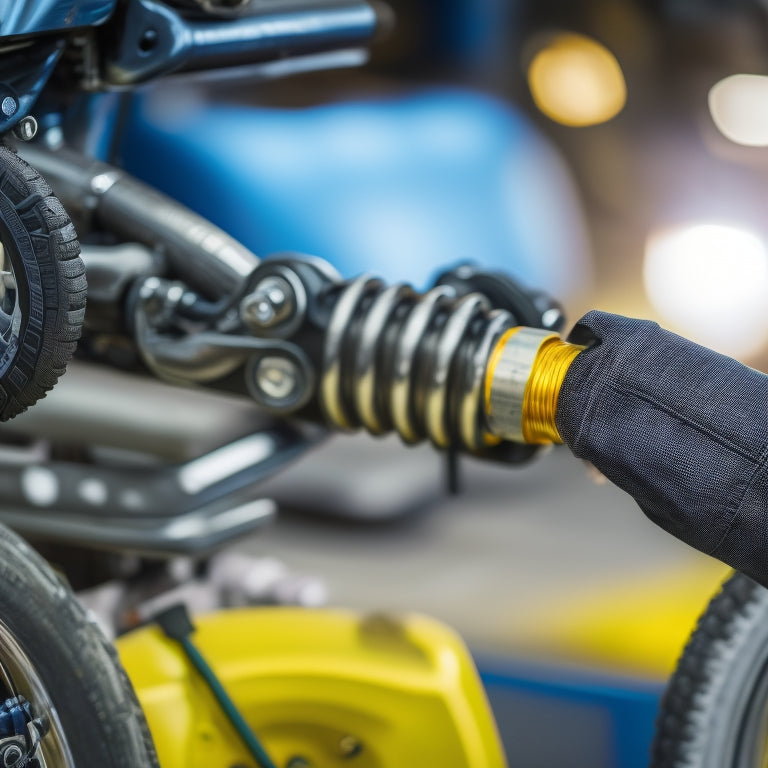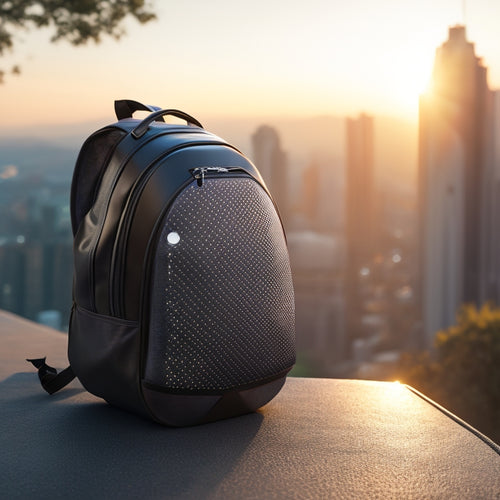
Tune Your Ride: Motorcycle Suspension Tuning 101
Share
You're about to reveal the secret to transforming your motorcycle's suspension, and it starts with understanding that a well-tuned suspension system is the difference between a mediocre ride and an unforgettable one. Electric motorcycle dynamics play a pivotal role, with torque delivery impacting acceleration and handling. Your suspension system consists of springs, dampers, and linkages, which must be balanced for peak performance. By setting sag and preload values, adjusting rebound and compression, and fine-tuning for your riding style, you'll be on your way to a customized ride. Now, take the next step to unleash the full potential of your bike.
Key Takeaways
• Mastering electric motorcycle dynamics involves balancing torque delivery, regenerative braking, and suspension tuning for optimal performance.
• A well-tuned suspension system requires correct sag and preload values, which are affected by rider weight and spring rate.
• Adjusting rebound and compression damping ratios is crucial, with a starting point of 3:1 or 4:1, and fine-tuning for rider preferences.
• Rider ergonomics and bike geometry alignment are essential for optimal suspension performance and personalized handling.
• Experimentation with different damping rates and suspension travel settings is necessary to achieve a tailored ride that suits individual riding styles.
Understanding Electric Motorcycle Dynamics
As you ride an electric motorcycle, its dynamics are shaped by the intricate interplay of electrical and mechanical components, which demands a deep understanding of the complex forces at play.
You need to grasp how torque delivery, for instance, affects your bike's acceleration and handling. The instant torque provided by electric motors can be both a blessing and a curse, as it can lead to wheel spin or loss of traction if not managed properly.
Regenerative braking, on the other hand, can greatly impact your bike's dynamics, especially during deceleration. As you brake, the motor becomes a generator, converting kinetic energy back into electrical energy, which can influence your bike's stability and responsiveness.
Understanding how these components interact is vital to optimizing your electric motorcycle's performance. By mastering the interplay between electrical and mechanical components, you'll be able to fine-tune your bike's dynamics, enhancing its full potential and elevating your riding experience to the next level.
Suspension Components and Functions
Your electric motorcycle's suspension system, comprising springs, dampers, and linkages, works in tandem to absorb bumps, maintain traction, and stabilize your ride.
The springs, which come in various spring rates, store energy as they compress and decompress, allowing the motorcycle to move up and down. The spring rate determines how much force is required to compress the spring, with higher rates providing more support and lower rates offering more flexibility.
Dampers, on the other hand, control the speed at which the suspension compresses and decompresses. There are two primary damping types: compression and rebound. Compression damping slows down the compression of the suspension, while rebound damping slows down the rebound. A well-tuned suspension system balances these two damping types to maintain control and stability.
Understanding the functions of these components is essential in achieving excellent suspension performance. By selecting the correct spring rate and damping type, you can customize your motorcycle's suspension to your riding style and the terrain you'll be tackling.
Setting Sag and Preload Values
You'll need to set the sag and preload values to enhance your motorcycle's suspension performance, ensuring it responds correctly to varying road conditions and riding styles. To do this, you'll need to take into account your rider weight, as it directly affects the suspension's behavior. A heavier rider will require more preload to maintain the correct sag, while a lighter rider will need less.
Sag, or static sag, refers to the amount of compression the suspension experiences under the rider's weight. Typically, it's set between 25-35mm. To measure sag, sit on the bike and have a friend measure the distance between the rear axle and a fixed point on the bike. Then, get off the bike and take the same measurement. The difference between the two measurements is your sag.
Once you've set the sag, you'll need to adjust the preload to achieve the correct spring rate. The spring rate is the amount of force required to compress the spring by a certain distance. A higher spring rate means a stiffer spring, which may be necessary for heavier riders or those who ride aggressively.
Adjusting Rebound and Compression
With the sag and preload values set, it's now vital to fine-tune the rebound and compression damping to achieve peak suspension performance. You're getting close to realizing your motorcycle's full potential! Adjusting rebound and compression damping requires a deep understanding of how these components interact.
Rebound damping controls the speed at which the suspension returns to its neutral position, while compression damping regulates the pace of compression. A general rule of thumb is to start with a 3:1 or 4:1 damping ratio, where the rebound damping is three or four times the compression damping. However, this ratio can vary depending on your bike's spring rates and your riding style.
It's essential to experiment with different damping ratios to find the sweet spot. Remember, a well-tuned suspension is all about balance. If you're too stiff, you'll lose traction, and if you're too soft, you'll sacrifice stability. By finding the perfect harmony between rebound and compression, you'll be carving up the twisties in no time!
Fine-Tuning for Rider Preferences
Now that the suspension's foundation is set, it's time to tailor the damping to your riding style and preferences. You've adjusted the rebound and compression, but fine-tuning for rider preferences is where the magic happens. This is where you dial in the personalized handling that makes your ride feel like an extension of yourself.
Here are the key areas to focus on:
-
Rider ergonomics: Confirm your body position and ergonomics align with the bike's geometry, allowing you to maintain control and comfort.
-
Damping characteristics: Adjust the damping rates to suit your riding style, whether you're a smooth cruiser or an aggressive corner-carver.
-
Suspension travel: Fine-tune the suspension travel to match your riding terrain and style, ensuring the bike responds predictably to every bump and turn.
- Personalized handling: Experiment with different settings to find the perfect balance of stability, agility, and feedback that makes you feel connected to the road.
Frequently Asked Questions
Can I Tune My Motorcycle Suspension Myself or Do I Need a Mechanic?
You can try tuning your motorcycle suspension yourself, but be prepared for DIY challenges. Without experience, it's easy to misadjust and compromise performance or safety. Consider seeking professional guidance to guarantee a smooth ride.
How Often Should I Check and Adjust My Motorcycle's Suspension Settings?
As you ride, imagine your motorcycle's suspension as a harmonious dance, adapting to every bump and curve. Check and adjust your settings every 1,000 to 3,000 miles, depending on your ride frequency and road conditions, to guarantee a smooth, responsive ride.
Will Upgrading My Suspension Components Improve My Motorcycle's Performance?
Upgrading your suspension components can greatly enhance your motorcycle's ride quality and handling dynamics, allowing you to carve corners with confidence and soak up bumps like a pro, but it's not a one-size-fits-all solution.
Can I Use Suspension Settings From a Similar Bike on My Motorcycle?
"Did you know 75% of riders overlook suspension tuning? When borrowing settings from a similar bike, consider bike comparisons and rider weights; a 150-pound rider on a 500-pound bike needs different settings than a 200-pound rider on the same bike."
Do I Need to Re-Tune My Suspension After Changing My Motorcycle's Tire Size?
'When you swap to a new tire size, you'll likely alter your bike's Tire Weight and Ride Height, so yes, you'll need to re-tune your suspension to guarantee peak performance and handling.'
Related Posts
-

Why Regular Vehicle Panel Maintenance Matters Locally
You know that regular vehicle panel maintenance is essential to optimize your vehicle's performance, energy efficienc...
-

Charging On-The-Go: Portable Battery Solutions Online
You're always on the move, and your devices need to keep up - that's why having a reliable portable battery solution ...
-

Why Are Online Prices for Panels So Low?
When you buy panels online, you're often taking advantage of a combination of factors that drive prices lower. You're...


